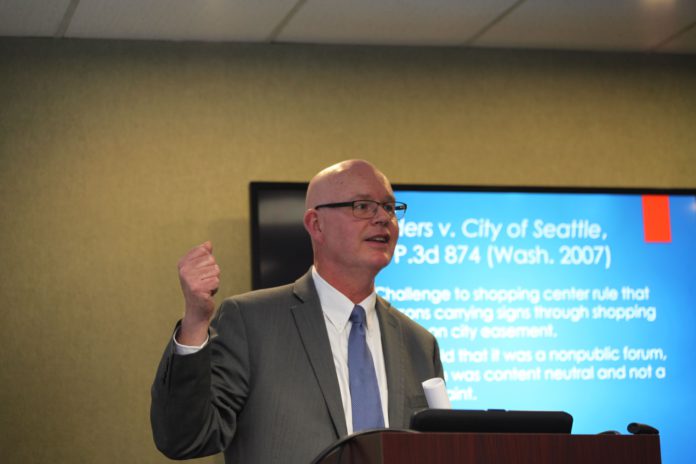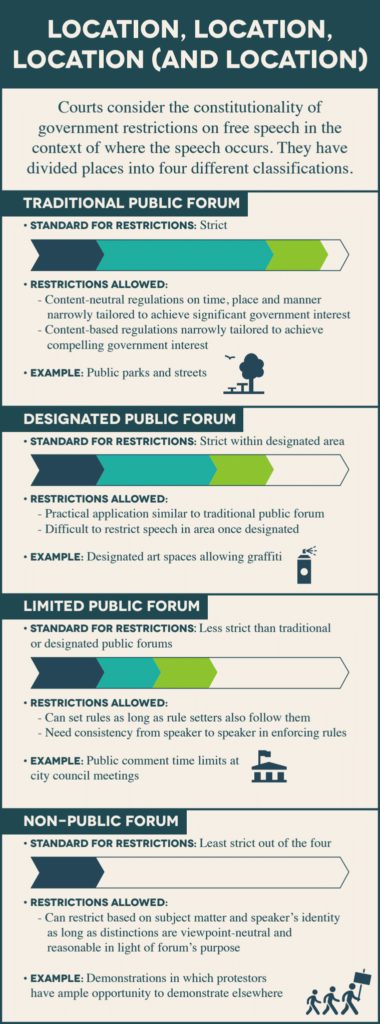
The balance of free speech rights with public safety has risen to the top of consciousness recently in the wake of last summer’s Unite the Right rally that injured dozens of demonstrators and killed one, as well as rallies for gun control across the U.S. after the mass shooting at Marjory Stoneman Douglas High School in February.
Conditions for when the government can restrict speech are certain only in their uncertainty. The constitutional right can sometimes butt up against public safety concerns, and those charged with protecting the two sides of the balance acknowledge the same shaky qualifier: Governments’ ability to restrict expression depends on the circumstances. As Boulder City Attorney Thomas Carr explained in a CLE session Tuesday, the consideration is especially important when speech at issue causes controversy or outrage, because the First Amendment does not allow governments to discriminate based on whether they like the speech.
“There are people who want to say things that are offensive to me, to most people in this room, to most people in America, but they have the right to say that,” Carr said. “And that’s an uncomfortable conversation to have with your elected leaders who don’t necessarily want that speech.”
Courts consider restrictions on speech in the context of where it takes place. Places fall into four broad classifications: A traditional public forum, a limited public forum, a designated public forum or a non-public forum. Each setting has different implications for how much the government can restrict speech within them. But content- and viewpoint-based restrictions in each type are kryptonite for a government’s justification, because they seldom stand up to the strict scrutiny to which courts subject them.
In a traditional public forum, Carr explained, speech is difficult to justify restricting. A government can regulate the time, place and manner of speech in a traditional public forum in a content-neutral way, but the regulations must be narrowly tailored to achieve a significant government interest. Enforcing a content-based restriction requires a government to prove a narrowly tailored compelling state interest. Carr said content-based restrictions are “nearly impossible” to justify. Common examples of traditional public forums include public parks and sidewalks.
Designated public forums have a similar standard to meet for restrictions on speech that occurs within them. Although a government does not have to indefinitely keep the area designated public, it will have difficulty restricting speech once opened.
In his explanation of designated public forums, Carr offered a seemingly rare example of how a specifically chosen area can protect expression the First Amendment might not otherwise cover. If a city commissions a graffiti artist to decorate a particular public area, the city would as a result have difficulty justifying the restriction of other artists from putting graffiti in that area as well.
In a limited public forum, a government has more ability to regulate speech than in traditional or designated public forums. But the government must also follow the rules it sets. Carr used city council meetings as an example, where a council can limit how long public commenters can speak for, but must enforce the limit consistently to avoid content or viewpoint-based restrictions. The council can’t let a commenter whose remarks they agree with speak beyond the set time limit, while cutting off other speakers who make offensive or controversial comments.
A non-public forum has the least strict standard for regulations of speech out of the four types of forums. A government can restrict expression based on subject matter and a speaker’s identity as long as the distinctions are viewpoint neutral and reasonable in light of the forum’s intended purpose.
The U.S. Supreme Court decided a case in 2015, Reed v. Town of Gilbert, that has since had significant implications for content-based restrictions on signs. A traveling church in Gilbert, Arizona posted large signs around town to alert congregants about upcoming gatherings. The town cited the church for violating its sign code, but Arizona law prohibits regulations on political signs.
“You can’t really talk about the First Amendment unless you talk about Reed,” Carr said. Justice Clarence Thomas wrote the opinion, which established a simple standard for content-based restrictions. “Justice Thomas in Reed said if you have to look at the sign to determine whether the law applies, it’s content based and therefore requires strict scrutiny. A very simple test to apply, but a little difficult. We’re kind of working our way through the law post-Reed.”

Carr used last summer’s Unite the Right rally in Charlottesville as an epitome of the sometimes thorny balance between free speech rights and public safety.
White nationalist organizer Jason Kessler received a permit to hold a demonstration in Emancipation Park to protest the planned removal of a Robert E. Lee statue. Groups of counter-protesters also received permits.
Shortly before the Unite the Right demonstration, the city of Charlottesville revoked Kessler’s permit and issued a new one for McIntire Park, citing public safety concerns. Kessler sought an injunction against the revocation.
A judge granted Kessler’s request on the grounds that the revocation was content-based, because city only took away Kessler’s permit and had not sufficiently explained their concerns about public safety.
“It’s something that can happen to anybody,” Carr said of situations such as in Charlottesville that can unpredictably spin into violence despite governments’ best intentions to prevent it. “When someone wants to be violent in a demonstration, it changes the nature of the interaction. And it gets very messy.”
With the Charlottesville riots in mind, he offered a framework for municipal attorneys trying to balance public safety with free speech rights in regulating demonstrations and protests. Imagine the worst-case scenario, and tie any regulations closely to that worst case to show a narrowly tailored government interest.
“I’m not sure that separating the demonstrators would have prevented the violence [in Charlottesville],” Carr said. “These are really strongly held feelings. And one of the challenges presented by the First Amendment is that it’s designed to allow for the expression of strongly held feelings. It’s designed to allow for the conflict. And as a government lawyer, trying to convince people that that’s the case can be very difficult.”
—Julia Cardi

